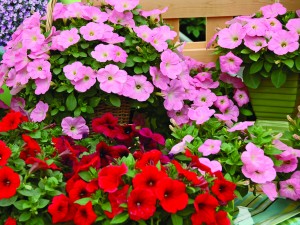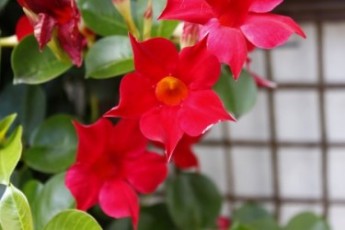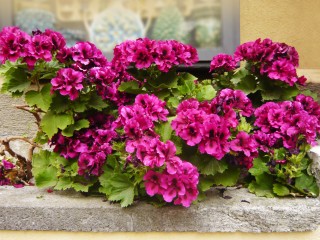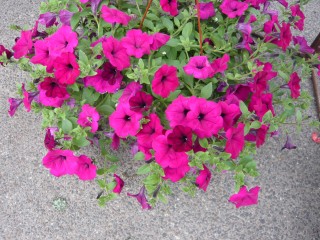In spring, after the frosts it is a high time for balconies, windowsills and terraces decoration with shrubby and leaning summer flowering flowers with decorative leafs. Properly selected and cared plants of miniature flower garden, created in hanging or standing pots, shall delight throughout the entire summer with its brightness, colorfulness and odor.
Choose the right plants to decorate the desired spot
In the southern part of the house (where the sun shines all day), on the sunny balcony or terrace, the sun-loving plants grow the best, such as surfinia, petunia, verbena, marigold, lantana, gypsophila, nemesia, purslane, sage, sanvitalia, tagetes.
If the balcony or terrace is on the southeast or southwest side, the most suitable are pelargonium, pink queen, New Guinea or Valero balsam, lobelias, immortelle, alehoof, sutera.


Balcony on east side gets afternoon and evening sun. Also, this place is open to winds so the hanging baskets and trays must be firmly fastened, where the firm and compact plants must be planted. Shrubby flowers are suitable for planting here, such as: pelargonium, verbena, petunia, all flowering begonia, coleus, sage, rudbeckia, “Toto” and etc. as well as leaning pelargonium, verbena, compact surfinia, sutera, immortelle.
The northern side is almost always in the shade. Plants in semi-shady and shady places, evaporates less water so the moisture stays longer in the substrate. Such place is the best for various begonias, New Guinea or Valero balsam, fuchsia, torenia, lobelia, loosestrife, alehoof, sutera, plectranthus.
Use a suitable substrate for flowers cultivation
The most suitable substrate for balcony flowers cultivation is the one with pH 5,5-6,5, enriched with complex fertilizers and trace elements also made of mid-peat fraction. Too acid or alkaline earth or substrate cannot be used as the plants will not absorb nutrients, will look poor and non-decorative.
Prepare the drainage
First of all, it is necessary to make the hole in the bottom of the new pot for excess water of fertilizers solution run off and to make 3 cm draining layer. Here expanded clay, coarse gravel or clay pot shivers can be used. Expanded clay is more suitable for hanging baskets and trays as it is lighter than the other materials, while there is no difference for standing pots.
Pots filling with substrate
Trays, hanging baskets or standing pots shall not be completely filled with the soil mixture, leaving 2,5 – 3 cm from the top, so as planting the flowers, the soil would not fall out as well as the water would not leak over during the watering.
Planting
Only healthy, dark green, not-yellowish, compact, non-elongated plants with well-developed roots shall be planted into the pots. Plants, not less than one hour prior the planting shall be watered, in order the substrate and roots will be well moistened. Plants shall be planted not too deep and not too shallow, well hiding the roots and then abundantly watered.
Watering
If flowers grow in the pots with small amount of peat substrate, it dries out fairly quickly and plants die. Flowers planted in pots shall be watered twice a day in hot summer days. Water shall be soft and tepid. Trays with 8 cm height saucers as well as hanging pots with saucers for excess water collection shall be used. Thus the substrate shall not dry so quickly after the watering or fertilization; also there will not be any risk of walls splashing.
Use moisture supporting materials
It is recommended to use special material “Terrakotem” granules for moisture to stay longer in the flower substrate, which help to maintain the permanent moisture of the substrate. Using 15 g of granules into 2 liter substrate, substrate “gel” is obtained (when granule swell it maintains the moisture for longer time). Then the flowers bloom more abundantly, with bigger blossoms and are of dark green color.
Plants overwatering or saddening due to long rain
Plants cannot be overwatered, as due to the long lasting moisture in the substrate, roots lack the air and cannot absorb nutrients so the plants become yellowish. This can also happen due to the too long rain. Flowers can be watered or fertilized only if the substrate is well dried.
Fertilization
Slowly soluble, complex fertilizers “Hydrocote” with trace elements are especially suitable for fertilization of balcony flowers compositions, planted into the pots. In order the well establish flowers would grow lush also would bloom brighter and longer they shall be fertilized with 0,2 proc. complex fertilizers solution “Nutricomplex” every 3-7 days. Large blossom surfinias are recommended to be fertilized more often – every second-third morning while the small blossom surfinias, kabloom pink and verbena – less frequently – every 4-5 days and pelargonium, begonia and fuchsia – every 7 days.
Plants protection against diseases and pests
Plants against aphids, whiteflies and thrips shall be sprayed with insecticide decis (of 0,1 percent) or actara (0,02 – 0,04 percent), against mildew – with fungicide amistaru (0,1 percent) or saprol (0,1-0,15 percent). In case of minor damages of plants – to spay with phytoncide plants (garlic, marigold, absinth, mugwort, tobacco dust) decoctions. Plants must be sprayed on cloudy day or in the evening.
For flowers blooming more abundantly not allow the maturing of seeds
Every day picking the blooms of over-bloomed flowers together with the stalks, grants the faster blooming of new blossoms. If taking off only the petals, the seeds primers remains, thus the flowers do not bloom so abundantly and look less decorative.
If any plant has withered within the summer, the other blooming plant can be replanted and the entire composition becomes alive again.









